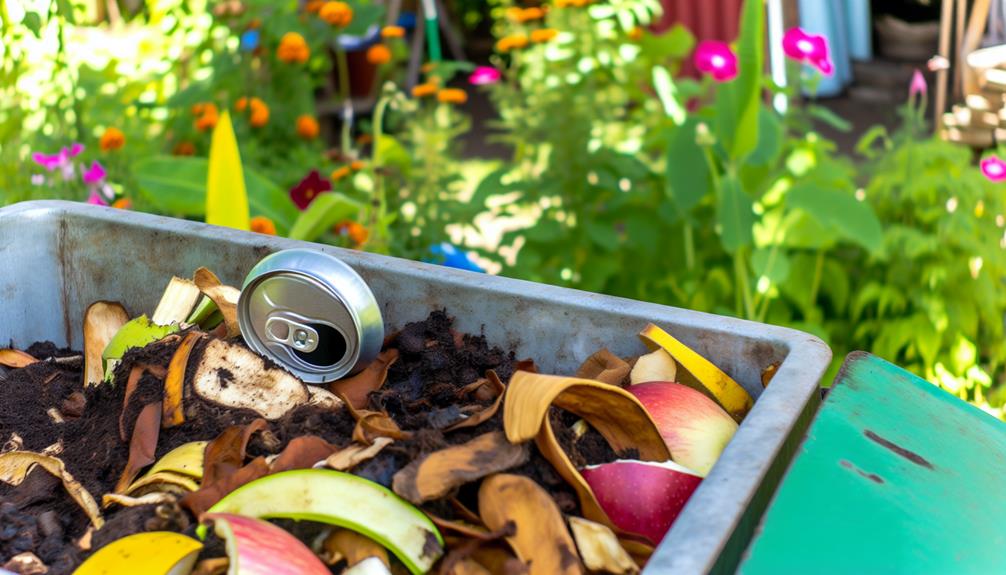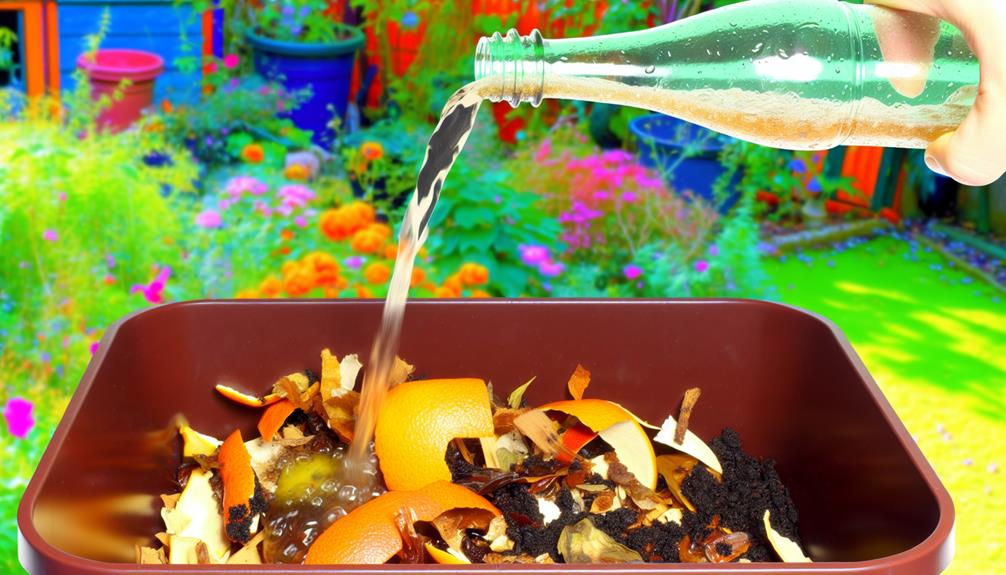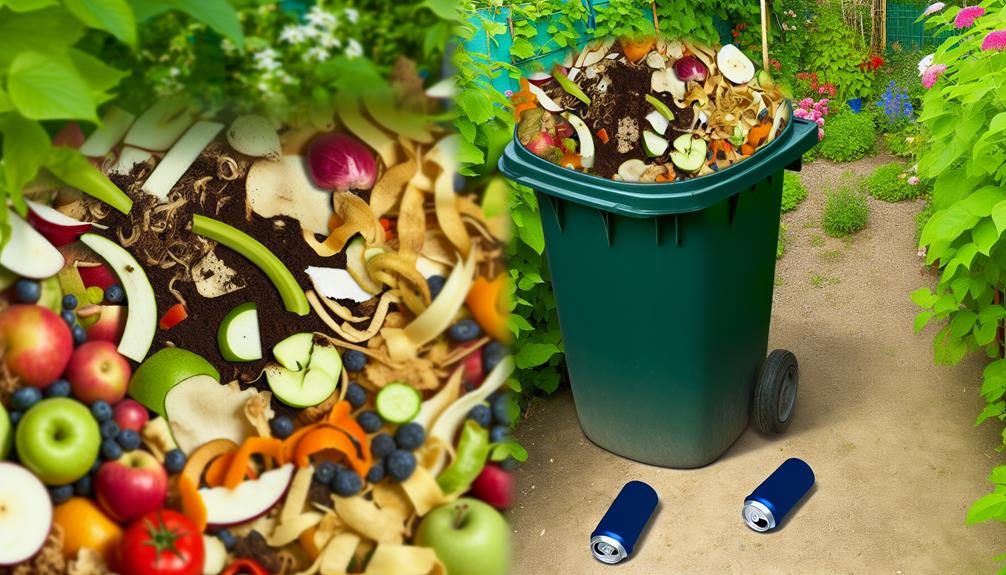

You can compost soda, but you need to do it carefully. The high sugar content can attract pests and speed up decomposition, which may disrupt your compost balance. Soda’s acidity can also lower your compost’s pH, affecting microbial activity and nutrient availability. To mitigate these issues, add soda in small amounts and mix well into your compost.
Balancing it with materials like crushed eggshells can help neutralize acidity. Remember to monitor moisture and turn the pile regularly. If you follow these guidelines, you’ll maintain a healthy compost pile. For more detailed steps and tips, exploring additional resources is beneficial.
When starting your compost pile, include kitchen scraps like fruit and vegetable peels, coffee grounds, and eggshells. These items break down quickly, adding essential nutrients to your compost. Don’t forget yard waste, such as grass clippings and leaves, which provide a good balance of carbon.
Here’s a quick guide to typical compostable items:
| Food Scraps | Yard Waste |
|---|---|
| Fruit peels | Grass clippings |
| Vegetable peels | Leaves |
| Coffee grounds | Small branches |
Food scraps like bread and cooked pasta can also be added. Just avoid any meat, dairy, or oily foods, as they can attract pests and create odors. Yard waste, including non-treated wood chips and plant trimmings, can also enrich your compost. Mixing these materials creates a balanced compost that’s rich in both nitrogen and carbon.
Remember to turn your compost regularly to aerate it and speed up the decomposition process. A well-maintained compost pile not only reduces waste but also produces valuable fertilizer for your garden. By including a variety of food scraps and yard waste, you’ll create a thriving compost system that benefits both your garden and the environment.
Also Read: Can You Compost Butter?
When contemplating soda for composting, you should first understand its ingredients. Soda contains high levels of sugar and acidity, which can impact the composting process.

These factors, along with the environmental impact of soda, are essential to take into account before adding it to your compost pile.
Soda is primarily composed of carbonated water, high fructose corn syrup or sugar, caffeine, and various artificial flavors and colors. When you’re breaking down soda’s ingredients, you’ll notice that caffeine content and artificial sweeteners play significant roles. Understanding these components helps you grasp why soda might not be ideal for composting.
Here’s a breakdown of common soda ingredients:
| Ingredient | Purpose | Common Types |
|---|---|---|
| Carbonated Water | Provides fizziness | Carbon dioxide infused water |
| Sweeteners | Adds sweetness | High fructose corn syrup, sugar |
| Caffeine | Adds a stimulating effect | Natural caffeine, synthetic caffeine |
| Artificial Flavors | Enhances taste | Various chemical compounds |
| Artificial Colors | Improves visual appeal | Red 40, Yellow 5, etc. |
Caffeine content in soda varies, but it’s an essential ingredient for many. It’s what gives you that energy boost. However, caffeine isn’t beneficial for compost. Similarly, artificial sweeteners like aspartame and sucralose, often found in diet sodas, don’t break down easily in compost. Artificial flavors and colors, though enhancing taste and appearance, consist of chemicals that are not compost-friendly.
Understanding soda’s composition wouldn’t be complete without examining the roles of sugar and acidity. Soda typically contains high levels of sugar, which can be an issue when you’re trying to compost it. Sugar is an organic matter, but in large quantities, it can attract unwanted pests like ants and flies to your compost pile. It also speeds up the decomposition process, potentially leading to a sticky, unbalanced mess.
Acidity is another critical factor to take into account. Most sodas are highly acidic, thanks to ingredients like phosphoric acid and citric acid. High acidity can disrupt the pH balance in your compost, making it less effective at breaking down other organic waste. Compost thrives best in a slightly acidic to neutral environment, so adding soda could throw off this balance.
To manage these issues, dilute any soda with plenty of water before adding it to your compost. This helps reduce both the sugar concentration and the acidity. Additionally, make sure you mix the soda with other compost materials like leaves, grass clippings, and vegetable scraps to create a balanced mix. By doing so, you contribute to efficient waste recycling while maintaining a healthy compost pile.
In considering the environmental impact of soda composition, you’re likely to encounter issues related to both waste management and resource consumption. Soda packaging, often made from plastic, aluminum, or glass, presents significant challenges. Plastic bottles contribute to landfill mass and marine pollution. Aluminum cans, while recyclable, require substantial energy to produce. Glass bottles are heavy and energy-intensive to transport and recycle.
| Material | Environmental Impact |
|---|---|
| Plastic | High waste, marine pollution |
| Aluminum | Energy-intensive production, recyclable |
| Glass | Heavy, energy-intensive transport |
Understanding these impacts can help you make informed choices about recycling options. When you recycle aluminum cans, you save up to 95% of the energy required to make new ones. Plastic bottles should be rinsed and sorted according to local guidelines to make certain they don’t end up in landfills. Glass, although less common for soda, should be cleaned and taken to designated recycling centers.
Your choices in handling soda packaging can make a tangible difference. Engage with community recycling programs and educate others about the importance of proper disposal methods. Everyone’s efforts contribute to reducing the environmental footprint of soda consumption.
When you add soda to your compost, the sugar can have a substantial impact on microbial activity. This change can alter the decomposition rate, sometimes accelerating it but also potentially causing imbalances.
It’s important to closely monitor your compost and make sure that the sugar levels don’t disrupt the natural process.
Sugary soda in your compost pile can supercharge microbial activity, leading to faster decomposition. When you add soda, the sugar content feeds bacteria and fungi, promoting microbial diversity essential for breaking down organic matter. This microbial diversity guarantees a balanced ecosystem within your compost pile, which is vital for effective decomposition.
However, you need to monitor and control the temperature. The accelerated microbial activity can cause the compost pile to heat up rapidly. You don’t want it to get too hot, as this can kill beneficial microbes and slow down the composting process. By managing the temperature properly, you can maintain an ideal environment for decomposition.
Here are some tips to keep your compost pile thriving:
Adding soda to your compost not only boosts microbial activity but also greatly speeds up the overall decomposition rate. The sugar in soda serves as an immediate energy source for microbes that break down organic matter. When these microbes are more active, your compost pile heats up faster and decomposes more efficiently.
Historically, composting has been a natural method for enhancing soil fertility, dating back to early agricultural practices. By incorporating soda into your compost, you’re tapping into this rich history while leveraging modern knowledge. The sugar content in soda accelerates the breakdown of organic materials, which means you’ll have rich, dark compost ready to use in your garden more quickly.
The benefits of composting with soda are numerous. Faster decomposition translates to quicker access to nutrient-rich compost, improving soil structure and fertility sooner.
Additionally, the increased microbial activity ensures a more balanced ecosystem within your compost pile, aiding in the breakdown of tougher materials like leaves and small branches.
Also Read: Can You Compost Broccoli?
The acids in soda can disrupt the composting process by altering the pH balance of your compost pile. Much like acid rain affects soil pH, the acidic content of soda can create an environment that’s too acidic for helpful microorganisms to thrive.
To keep your compost healthy, you’ll need to assess the impact of any soda you add.
Here are four key points to evaluate:
Many people wonder if carbonation in soda affects the composting process. When you pour soda into your compost pile, the carbon dioxide gas release from the carbonation can actually help. Carbon dioxide is a natural part of the composting process, and it can aid in breaking down organic materials.
However, you need to be mindful of the amount of soda you add. Too much carbon dioxide can disrupt the balance of gases in your compost, potentially slowing down the decomposition process. It’s best to add soda sparingly, ensuring it doesn’t dominate the pile. You want to maintain a healthy mix of greens (nitrogen-rich matter) and browns (carbon-rich matter) to keep your compost thriving.
When adding soda, make sure it’s flat to minimize immediate gas release. This way, the carbon dioxide will integrate more gradually, providing a steady supply rather than an overwhelming burst. Stirring your compost pile after adding soda also helps distribute the gas evenly.
Balancing nutrients in your compost pile is crucial for guaranteeing efficient decomposition and rich, fertile compost. You need to maintain proper nutrient ratios to create an ideal environment for composting. This means managing the balance of carbon-rich ‘browns’ (like leaves and cardboard) and nitrogen-rich ‘greens’ (like vegetable scraps and grass clippings).
Here are some key tips to achieve compost balance:
If you can’t compost soda, consider these alternative disposal methods to minimize environmental impact.
One effective way is to pour soda down the drain, ensuring you do so slowly to prevent any potential plumbing issues. This method helps reduce waste in landfills.
Another option is to recycle the soda bottles or cans. Recycling benefits the environment by reducing the need for new raw materials and conserving energy. Make sure to rinse out the containers before placing them in the recycling bin. By doing so, you contribute to waste reduction and help keep recycling systems efficient.
You can also use soda in practical ways around the house. For instance, soda’s acidity makes it a good cleaner. Use it to remove grease stains or clean toilets. These small actions can help cut down on household waste and make use of a product that might otherwise be discarded.
Also Read: Can You Compost Black-Eyed Peas?
To get the most out of your compost pile, focus on maintaining the right balance of green and brown materials. Green materials, like fruit scraps and grass clippings, are rich in nitrogen, while brown materials, such as leaves and cardboard, provide carbon. This balance is essential for effective decomposition and maximizing the composting benefits.

Here are some best practices to follow:
You can’t compost diet soda effectively. Its nutrient breakdown and lack of sugar content don’t provide the necessary elements for composting. Stick to composting organic materials to foster a stronger, more vibrant community garden.
Soda’s sugar content negatively impacts worm health. When you add soda to your compost, it disrupts the worms’ environment and digestion. Stick to compost-friendly materials to guarantee your worms thrive and feel at home.
Yes, flat soda’s better for composting. The carbonation impact is gone, making it easier for microbes to break it down. However, be careful about the nutrient balance to avoid harming your compost community.
You can’t compost soda cans because they’re made of materials that don’t break down in a compost bin. Stick to organic waste for composting, and you’ll contribute to a healthier, more sustainable community.
Yes, soda can attract pests to your compost pile. For pest prevention, use natural alternatives like water or homemade compost tea. This helps maintain a healthy compost community that everyone can feel good about.
To wrap up, while composting soda isn’t ideal due to its high sugar and acid content, you can still manage your compost effectively. Instead, stick to typical compostable items like fruit peels, vegetable scraps, and coffee grounds.
If you accidentally add soda, balance it with more brown materials like leaves or cardboard. Always strive for a balanced nutrient mix to guarantee healthy compost.
Remember, understanding what to compost helps maintain a thriving and efficient compost system.

Don't let aphids, slugs, and caterpillars ruin another plant. Take back control with simple, natural methods that actually work.